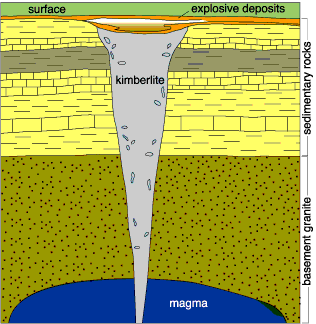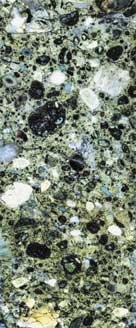Kansas Geological Survey, Public Information Circular (PIC) 16
Prev. Page--Start of the Report || Next Page--History
![]()
![]()
![]()
![]()
Kansas Geological Survey, Public Information Circular (PIC) 16
Prev. Page--Start of the Report ||
Next Page--History
Unlike most of the surface rocks in Kansas, which are sedimentary in origin, kimberlite is an igneous rock, formed from the cooling of molten magma. Igneous rocks are extremely rare in Kansas. Kimberlite is composed of at least 35% olivine, together with other minerals such as mica, serpentine, and calcite (Jackson, 1997). Geologists call it an ultrabasic rock, which means it does not contain any quartz or feldspar, the two most common rock-forming minerals. Olivine, the main mineral constituent of the rock, is an olive-green, grayish green, or brown mineral made up of magnesium, iron, and silica. In 1888, the name kimberlite was proposed for this particular rock, based upon the occurrence of these rocks in the vicinity of Kimberley, South Africa.
Large volumes of an olivine-rich rock type called peridotite occur at great depths in the earth in a layer called the mantle. At these depths (100-135 miles or 150-200 km), the combined temperature and pressure is high enough to partially melt some of the peridotite. If volatile gases, such as carbon dioxide and water, are present, they may propel the molten peridotite upwards, forming a kimberlite magma. As the hot kimberlite magma rises slowly upward into regions of lower temperature and pressure in the upper mantle and overlying crust, minerals start to crystallize and the volatile gases expand and exert increasingly higher pressures on the surrounding rocks, eventually breaking some of the surrounding rock and incorporating it into the magma. Closer to the earth's surface the internal pressures of the magma and volatile gases become so great that the kimberlite becomes explosive (fig. 2). Kimberlite magma can rise toward the surface at speeds estimated at up to 400 meters (1,200 feet) per second, ripping up more and more pieces from the surrounding rock, which gives the kimberlite its characteristic texture (fig. 3).
Figure 2--Generalized diagram of a kimberlite pipe.

Figure 3--Polished kimberlite core sample.

Prev. Page--Start of the Report || Next. Page--History
Kansas Geological Survey, Public Outreach
Web version July 2000
http://www.kgs.ku.edu/Publications/pic16/pic16_2.html